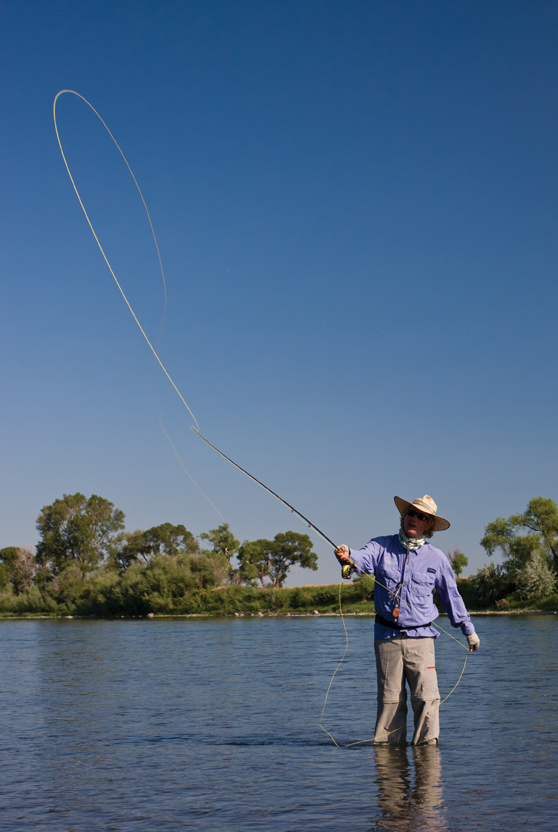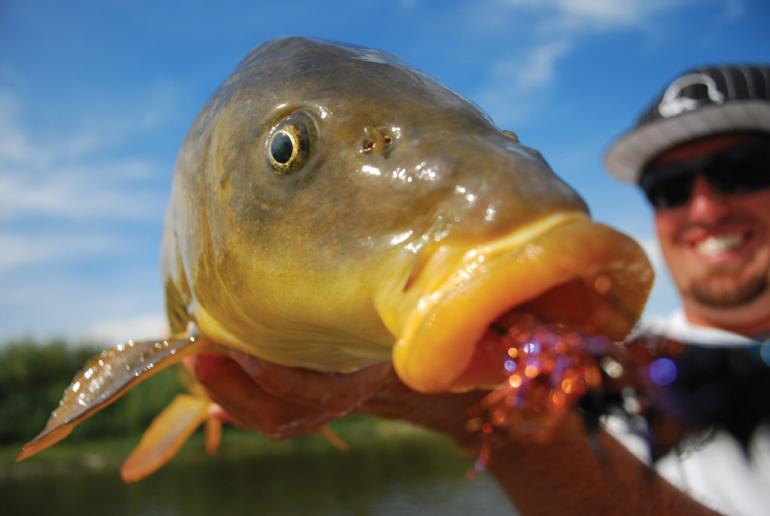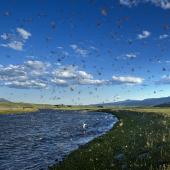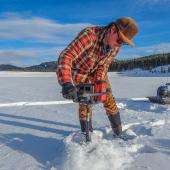Chasing the Golden Beast
It seems pretty strange that in a beautiful state like Montana—replete with pristine lakes, rivers, and streams chock full of beautiful brown, rainbow, and cutthroat trout—groups of fly-fishing bums would be excitedly searching muddy ponds and murky waters for a lowly trash fish that Midwesterners catch with corn and cheese balls. But it’s true—they’re doing it. And yes, we’re talking about fly fishing for carp. Before you scoff, realize that these testy fish can reach sizes well past ten pounds and pull like a Mack truck, inspiring any angler to try fishing for carp at least once.
If you’re turned off by the stench of month-old garbage and fish slime so thick that it must have come from Slimer in Ghostbusters, carp fishing might not be for you. But if you don’t mind wading conditions that would make a frat boy blush, then you just might be cut out for carping. If you are, read on and I’ll be happy to indulge your fly fishing fantasies with the animal so lovingly referred to as the “Golden Beast.”
Why Would You Fish for Carp?
This is a question that one commonly gets when talking to other trout aficionados about the act of pursuing what most of the angling world refers to as a “trash” fish. But the first time you drive a piece of steel through that rubbery Hoover vacuum attached to a carp’s face, you’ll find out—these things can flat-out fight. When encountered in a river scenario, carp can put a savvy angler to the test when trying to land them on a conventional trout setup.
Really, the draw of carp fishing is the challenge of the fish and the situational fishing that they provide. Despite their reputation to feed on anything in front of them, carp can actually be quite challenging to catch—especially in trout country where they often dine on the same insects, crustaceans, leeches, and baitfish that you find in the bellies of Salmo trutta (brown trout) and Oncorhynchus mykiss (rainbow trout). Don’t believe me? Try crashing a giant wooly bugger into a pod of feeding carp and see how they react—they’ll ignore you. Studying the feeding behaviors of the Golden Beast is a must to pull any carp out of the water with a fly rod. Sometimes you’ll encounter them feeding on the surface, and other times they simply seem to be cruising around in no particular pattern. Try to find a group of them with their tails pointed high in the air and mud plumes wafting up from the bottom of the sandy flats as they search for food.
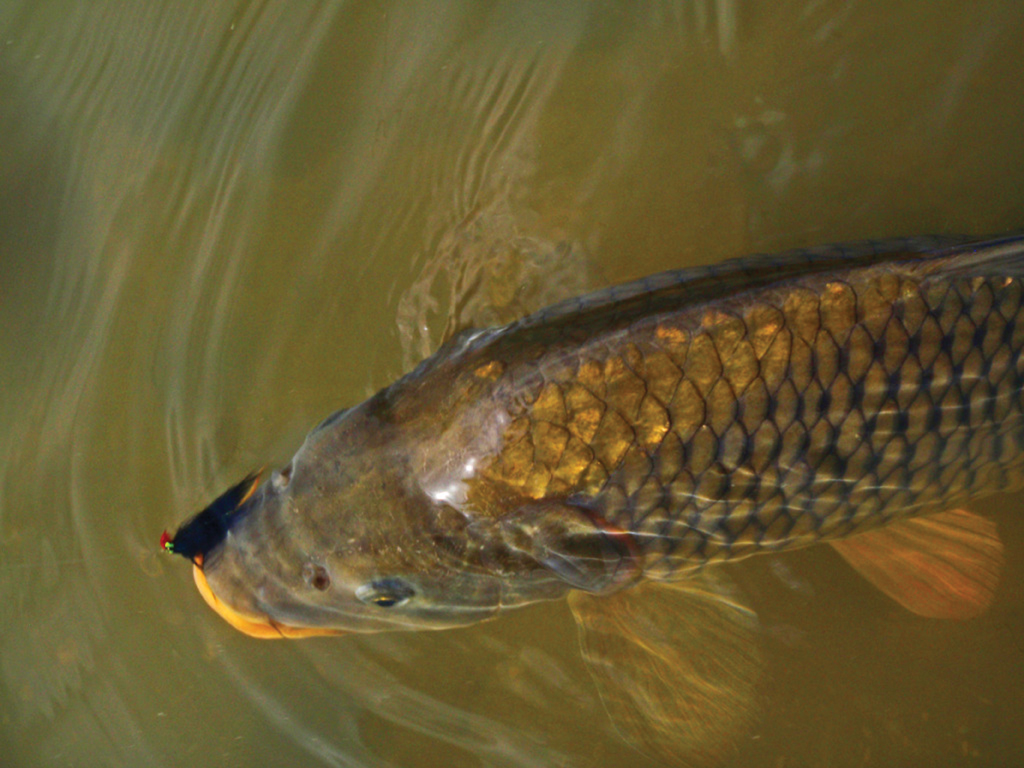
Diet and Flies
It’s better to understand what the local food base is where you’re fishing before you go throwing flies at these guys. Have a selection of patterns that mimic the food sources you’re likely to encounter. Nailing down the most prolific of those food sources and observing the carp’s feeding behaviors will give you an even better idea of what flies to use in a given situation.
For most rivers, you’d do well to have a pattern or two that mimics a decent-sized leech or sculpin, and in areas rich with crayfish, crustacean patterns can be dead-drifted and slowly retrieved with a fair amount of success as well. Popular trout patterns like Yuk Bugs and Rubberlegs work well as general flies if you dead-drift them under an indicator. Big black leech patterns are a staple in most carp fishermen’s boxes, and on rivers with rich baitfish populations, Zonkers and other minnow patterns are very effective. Play around with the colors if you’d like, but more often than not, success is had in going back to black.
Fly selection and dietary preferences on lakes and still bodies of water can vary wildly from those in rivers, and oftentimes the carp are pickier feeders—mostly due to the fact they get more time to look at the patterns you’re presenting. Smaller leech patterns generally are better than larger ones, and smaller nymph patterns with Rubberlegs twitched along the bottom in front of feeding fish can be very effective as well. Crayfish are a staple on many area lakes and ponds, and worm patterns work quite well at times. Suggestive patterns that don’t mimic any specific food source work the best in a lot of situations—the Backstabber by Jay Zimmerman is one of the best carp patterns out there. A variation on that pattern—dubbed the Cheerio Plugger—is my personal favorite for weary carp on lakes and ponds.
What You Need and What You Don’t
If you do head out carp fishing, you’re going to want to leave your 4 and 5-weight trout rods at home. Invest in a fast and stiff 6-weight, or even a 7-weight rod if you’re serious about it. (Or bring along a 6-weight that you don’t mind breaking—because it will happen.) My personal favorite carp stick is the Sage TCX 690 (it’s really more like a 7-weight). A reel with sufficient enough drag to slow the fish down in rivers is ideal, but don’t be swayed into buying a saltwater-capable drag for carp—it’s overkill. You really only need something to keep the line from free-spooling on you when the Golden Beast takes a good run. Ideally you’ll want to get a line that turns over flies into the wind and can cast long distances, but be careful not to get anything that can’t also lay a fly down delicately if you need it to. Otherwise you’ll be spooking away all the fish within casting range as you crash your line down on the water. My favorite line is the SA Mastery Textured GPX Taper.
Polarized lenses are standard for any fly fisherman these days, but if you don’t have a pair of optically correct lenses that allow you to see through the water at appropriate angles without squinting all day, you’ll struggle spotting these behemoths that blend into the mud so well despite their beautiful golden shimmery scales. Tippet and leader wise, 7 1/2-foot to 9-foot and 1X to 3X should suffice—preference being toward fluorocarbon tippets as they are more abrasion-resistant. They’ll maintain their breaking strength better than monofilament and they’re more translucent in the water.
Buy high-end gear to catch the fish, but save your money on clothes, boots, and waders, etc. The best carp fishing is done in the late spring through summer when you can comfortably wade around in shorts and sandals. Keep in mind other carp fishermen will make fun of you if you show up at a local carp locale in $700 waders—think Keystone Light t-shirts and shorts for the proper attire. For the best information ever written on carp fishing, check out Carp on the Fly by Barry Reynolds, Brad Befus, and John Berryman—it’s simply the most comprehensive and complete piece of literature on carp fishing and well worth a read.
Where to Stick or Stalk a Few Carp
If you thought this was going to be a roadmap to all the hot carp spots around Bozeman, then you’re barking up the wrong tree. Good carp fishing spots are typically more highly guarded than trout spots by those crazy enough to call themselves carp fishermen.
The places you can fish for carp make them attractive too—stalking them along “sandy flats” and lakefront “beaches” can remind landlocked saltwater anglers of fishing the flats—if they can get over the mucky bottom and seagulls and pelicans feasting on the decaying carp carcasses scattered along the shoreline. You can find carp residing in many of the rivers around the state as well. River fishing adds the dynamic of presenting a fly in moving water to these tricky beasts, and when you finally do hook one: tighten your drag and hold on.
You can find some good carp fishing in the Bozeman Pond if you string up a line and wander around the banks of Bozeman’s favorite urban water body. Three Forks Pond also offers up some good but challenging carp fishing. Canyon Ferry boasts a burgeoning carp population and some of the best carp fishing in the state. You can also find them in the river that feeds and drains from Canyon Ferry as well—the Missouri. The Golden Beast graces the Madison, Jefferson, Bighorn, and Yellowstone rivers in places as well, just to name a few. The further east you head in Montana, the more odd places you can find carp. Some of my favorite places to carp fish are in drainage ditches, farmers’ livestock ponds, sections of river that are too warm for trout, and recreational parks where the locals eyeball you for stringing up a fly rod.
So as you sit around this spring, dreaming of picturesque mountain backdrops with meandering rivers dotted with the rings of rising trout, give a thought to the lowly, disgusting, stinky old carp, and of giving one a little exercise. After all, they all seem so fat—they could probably use a little jog on the end of a fly line now and then.
Kris Kumlien is the general manager of Montana Troutfitters in Bozeman on his better days.
